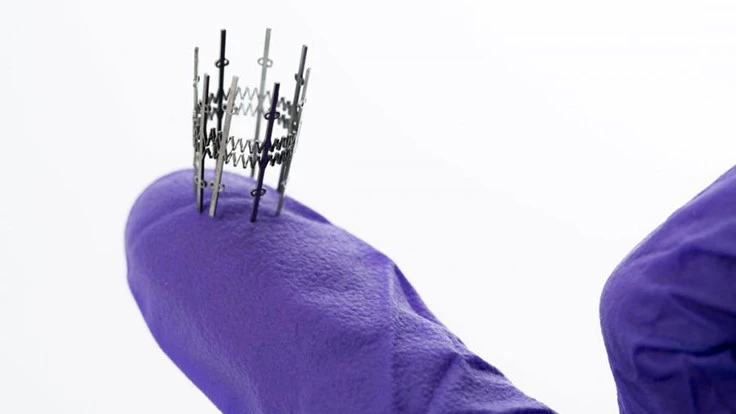
(Photo above) The pediatric heart valve stent was funded under a Draper initiative
called Engineering Impact that applies Draper’s capabilities and technologies
to global challenges. Photo Credit: The Charles Stark Draper Laboratory Inc.
A total of $150,000 in grants were recently awarded in Philadelphia, Pennsylvania, at the Sixth Annual Pediatric Device Innovation Symposium organized by the Sheikh Zayed Institute for Pediatric Surgical Innovation at Children’s National Health System.
In its award announcement, the Symposium recognized Draper for “developing a pediatric valve designed for children, birth to age 6, that passively expands to a two-fold change in valve diameter to accommodate child growth.”
Corin Williams, senior member of Draper’s Technical Staff, led the team that developed the pediatric heart valve stent – an invention they call the LEAP Valve, which stands for Low-force Expanding/Adaptable Pediatric Valve. The winners were selected from a field of 11 finalists, with 45 device submissions received from national and international innovators.
Earlier this year, May 2018, Resonetics released news of its involvement in collaborating with Draper in Cambridge, Massachusetts, to develop a pediatric heart valve frame – creating an implant that will grow with a child. The image below shows the nitinol valve frame cut and electropolished.

Children born with congenital heart valve defects number in the thousands each year, yet there are no artificial cardiac valves available that were designed specifically for babies. The LEAP Valve is designed to grow with the child.
Although doctors first implanted artificial heart valves in the 1950s, making a version for children has been a focus only recently, Williams says. “Developing a pediatric heart valve stent may seem straightforward but it is actually quite challenging when you need to account for growth. Our team kept at it, and after evaluating and narrowing down our ideas, the simplest solution was, surprisingly, one that had not been tried before: a device that would apply a low outward force like a spring, balanced with the patient’s growth. We like this solution because it doesn’t require a balloon catheter or other invasive methods to expand the valve as the child grows – it is designed to happen passively.”
Williams and her colleagues worked closely with pediatric clinicians, including a team led by Dr. Sitaram Emani at Boston Children’s Hospital, to design the LEAP Valve to fit a child’s specific needs. Ultimately, they hope the device will allow more centers to perform valve replacements in young children.

The pediatric heart valve stent is part of a Draper initiative called Engineering Impact that applies Draper’s capabilities and technologies to global challenges.
Next on the horizon is to take the LEAP Valve through animal testing and FDA approval, says Sheila Hemami, who as Draper’s director of strategic technical opportunities helped steer investment for the device. “Draper is actively seeking both technical and funding partners for the next important steps in bringing this device to the children who need it.”
Hemami adds, “Draper’s not-for-profit status enables us to work on problems in domains in which traditional return-on-investment would be a limiting factor for other providers of advanced engineering solutions. Working in conjunction with our partners, we form a unique resource to positively impact such challenges. The LEAP Valve is just that kind of solution.”
Latest from Today's Medical Developments
- EMO: Made for game changers
- Thomson’s encoder options for stepper motor linear actuator online selection tool
- BD boosts US manufacturing of critical medical devices
- Aerotech’s HexGen HEX150-125HL miniature hexapod
- World-leading medical device supplier via a new merger
- Edge Technologies' FMB Turbo 3-38 RS bar feeder
- Mazak’s new Customer Solutions Center
- maxon's High Efficiency Joint (HEJ) Drive





